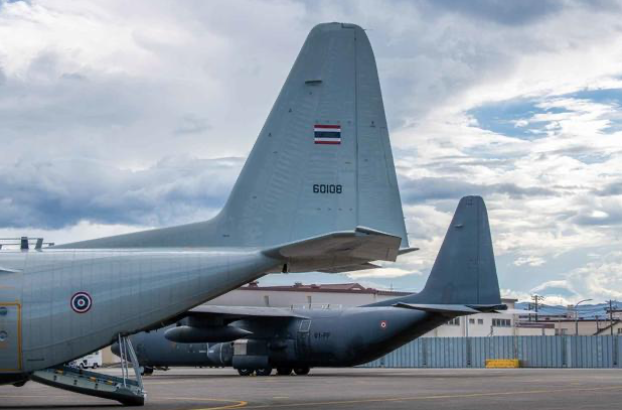By Jan Tegler
Publicly available flight tracking data is a growing problem for the U.S. military, a senior Pentagon official recently said.
Websites such as ADSBExchange.com, FlightRadar24.com and FlightAware.com aggregate flight data in the United States and abroad using a mix of commercial and citizen-owned sensors that capture the movements of commercial, civilian and military aircraft in real time, 24 hours a day.
“The Department of Defense considers open source flight tracking and data aggregation on our aircraft a direct threat to our ability to conduct military air operations around the world,” the Air Force said in a statement responding to National Defense’s questions. It cited a “senior Defense Department aviation policy expert,” who it declined to name.
Thousands of aircraft in flight are visible on the websites, displayed as silhouettes overlaid on digital maps that cover the globe. Click on a silhouette and users see aircraft type, identity and ownership, altitude, speed and heading/track as well as origin and destination information.
Capturing the data is possible because of international regulations that require aircraft to broadcast position information via radio-based transmitters known as transponders. Transponders allow air traffic controllers to coordinate the movement of aircraft and enable aircraft equipped with avionics and software that receive transponder signals to see other aircraft around them on cockpit display screens as they fly.
The transponder signals can also be captured by inexpensive, ground-based receivers that hobbyists, aviation enthusiasts and others can build themselves for less than $100 using widely available hardware and software, some of which can be obtained from the flight tracking websites.
In the United States, almost every type of plane — from airliners and small privately owned aircraft to military fighters, helicopters, bombers, tankers, intelligence-gathering aircraft, transports, special operations planes, drones, and even the VIP aircraft that carry the president and members of Congress — are required to transpond in controlled airspace.
Most are now equipped with Federal Aviation Administration-mandated Automatic Dependent Surveillance Broadcast transponders, known as ADS-B.
The Pentagon has agreements in place with the FAA and other international air navigation service providers to turn off ADS-B when it is deemed necessary. But to help facilitate the safe and efficient movement of air traffic, U.S. military aircraft routinely transmit via ADS-B and other transponder types.
That makes information on the movements of U.S. military aircraft available to anyone with an Internet connection.
Aggregated by the websites and relayed on social media accounts, the data can be a no-cost source of intelligence for nation states, terrorist groups or individuals, revealing everything from operational movements of aircraft, aviation units and troops to training patterns, developmental test flights and the movements of government officials, experts have said.
Robert Spalding, a senior fellow at the Hudson Institute and a retired Air Force brigadier general who commanded the 509th Bomb Wing flying the B-2, said he thinks open source information and “corruptible” social media are “more dangerous than the B-21.”
“That’s why I quit the military,” he said, “because we don’t protect data. I think that’s the most dangerous thing that we can do as a nation.”
Operational security is often neglected, he said. There are “pockets of awareness” about the risks of open source flight tracking data depending on what type of mission military personnel perform, he explained. But “there’s a general lack of awareness and it exists at the highest levels of the military and where the rubber meets the road,” he added.
“People aren’t technologically aware,” Spalding noted. “It really takes somebody showing them what they can do with the information they can collect to shock them into seeing how the things they’re doing are contributing to the potential to get your troops killed. Until they’re confronted with that information, it’s really hard to get them to pay attention.”
Retired Air Force Gen. David Deptula, dean of the Mitchell Institute for Aerospace Studies, said he would be “surprised in the extreme” if those leading the military’s combatant commands are not aware of the risks and are not taking action to negate open source flight tracking services.
“No one’s going to make a big deal out of it because it draws attention to the subject,” he said. “If you’re executing an ongoing operation that’s the last thing you want to have happen.”
U.S. military aircraft can opt to turn their transponders off, he said, adding that because the United States and other free countries have taken the approach that data should be open to everyone, “there’s not a whole lot you can do about it.”
The Pentagon aviation policy expert said operational security is always a top priority. “DoD carefully monitors” open source flight tracking, “taking it into account when planning and exercising military operations. This topic is a top priority during frequent discussions across military and civilian aviation organizations on a daily basis.”
However, the Defense Department has never contacted ADSBExchange.com, said the site’s president and founder Dan Streufert. The U.S.-based outlet has been in operation since 2016 and reveals as much live data on U.S. military aircraft globally as any flight tracking website.
“Nope. I’ve had absolutely zero contact from them,” Streufert said. “People always bring this up and I tell them that if there was an issue, I assume I would be contacted. I mean, we put Air Force One up there to track.”
Not only are live tracks of the VC-25s that serve as “Air Force One” when the president is aboard and other 89th Airlift Wing special mission aircraft shown on ADSBExchange.com, the site’s tracks of these and other U.S. military aircraft have been live-Tweeted on the Twitter accounts @USAirForceVIP and @AirForceTrack.
That is until Dec. 14, when Elon Musk, who recently acquired the social media giant, banned accounts that post flight data.
Streufert said he had heard rumblings “secondhand” that the Pentagon expressed “some surprise about how much movement information was available on Twitter.”
“I don’t know who made the comment but there is also apparently some talk about using this data to improve operational security, because if movements are showing up on our site, we’re obviously not the only ones that can see it,” Streufert added. “That’s a good flag that maybe OPSEC isn’t as tight as it needs to be.”
A pilot, aviation enthusiast and information technology professional, Streufert said he created ADSBExchange.com simply to help those who look into the sky, see an aircraft and wonder what it is or where it’s going figure those things out.
Unlike FlightRadar24.com or FlightAware.com — which rely on streams of flight tracking data provided by the FAA and other international aviation authorities or taken from Aireon’s ADS-B global air traffic surveillance and tracking satellite network as well as ground-based ADS-B receivers — ADSBExchange.com relies on thousands of independently owned ground-based ADS-B receivers and multilateration, or MLAT, devices.
MLAT receivers in groups of three or four in a small geographical area use triangulation to track aircraft. In other words, if an airplane is not using ADS-B to transpond as military aircraft sometimes do, MLAT receivers can still pick up their Mode-S transponder signals and establish a position and track for an aircraft as well as altitude and speed data.
Streufert said his website’s network of receivers includes 10,000 MLAT devices around the world. Because ADSBExchange.com doesn’t take flight tracking data from government or commercial sources, it can offer “unfiltered” flight tracking. But he doesn’t think his site poses any more risk than other open sources of data on military activities.
“I would hope there’s more than just a handful of $50 parts standing between military security and the enemy,” he said. “I think with their security posture they need to be aware that when you broadcast unencrypted from 30,000 feet, all of your information is going to be able to be picked up by people.”
The Pentagon’s aviation policy expert stated, “You will see that the only data that is available to the internet flight tracking websites is the independent and uncorroborated data that they collect on their own through persistent monitoring of air traffic control radio frequencies, which includes transponder emissions, data links and radio communications. Unfortunately, existing technologies do not allow for these open transmissions to be protected or encrypted and are necessary to navigate through the complex aviation ecosystem.”
Jake Harrington, a senior intelligence fellow with the Center for Strategic and International Studies, said open source flight tracking is part of the shift to what some call the “post-secrecy world,” wherein it’s much harder to conceal physical movements.
Meanwhile, using or manipulating flight tracking data to its own advantage could be a viable strategy for the U.S. military, he added.
“If adversaries are going to leverage these open source platforms to augment their own collection capabilities, they’re fair game in the intelligence space for denial, deception or other types of misdirection. It seems to make sense to send signals to potentially disrupt adversaries,” he said.
Streufert said he was “100 percent” certain the Pentagon has advertised the movements of its aircraft on occasion, citing the example of the war in Ukraine.
“If you go to our website and look at the news section there’s animation that shows a few days after Ukraine heated up, there was an orbiting refueling plane,” he said. “And you could see an F-35 on ADS-B showing up, taking fuel, patrolling near the border then leaving the area.
That clearly was a signal to tell the world, ‘We’re here.’”
Deptula said he thinks the military has “some pretty savvy information warfare operators who I would believe and hope would use these capabilities to deceive and otherwise distract potential adversaries.”
The Pentagon’s aviation policy expert said, “The DoD maintains that the many advantages that modern technology offers to the aviation community cannot disrupt or undermine military operations, and we are committed to finding solutions that balance the needs of all the stakeholders involved.”
The Navy, Marine Corps and Army were contacted to comment on this story but declined.




